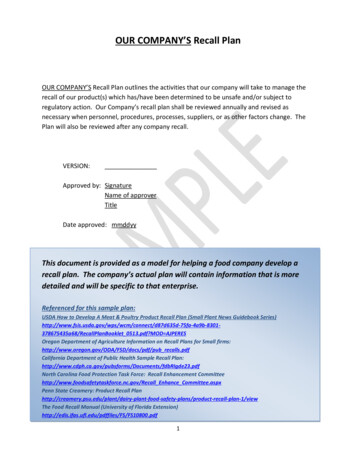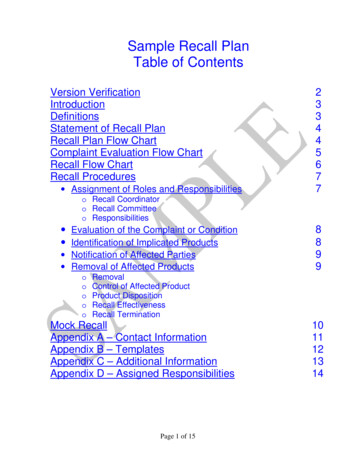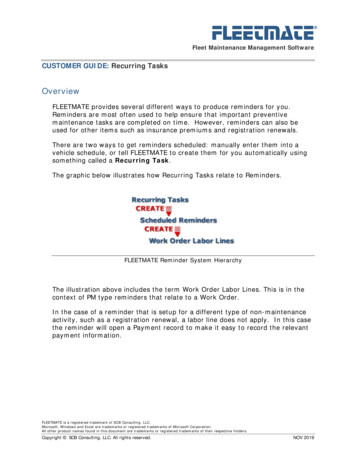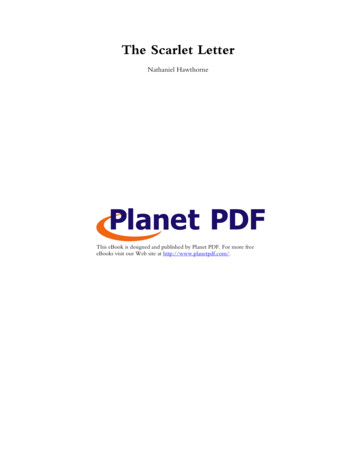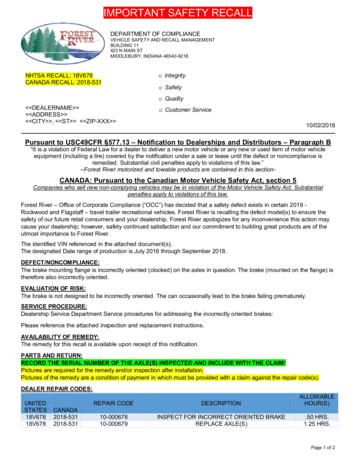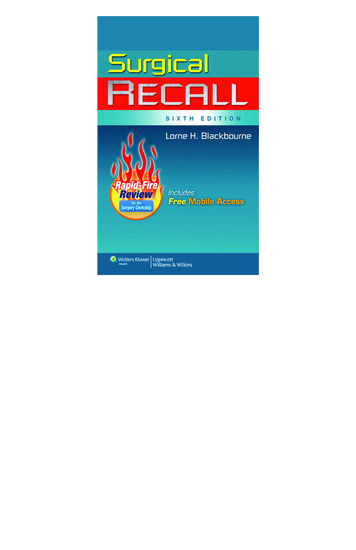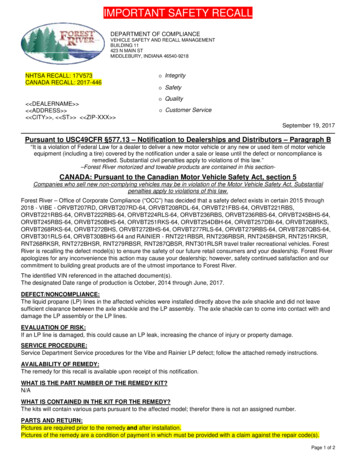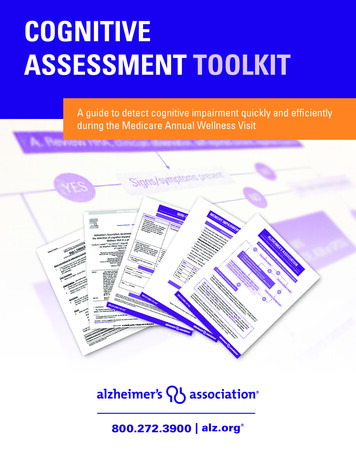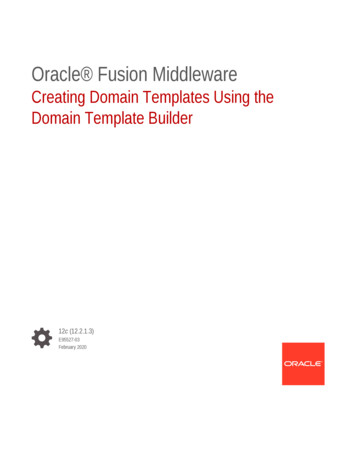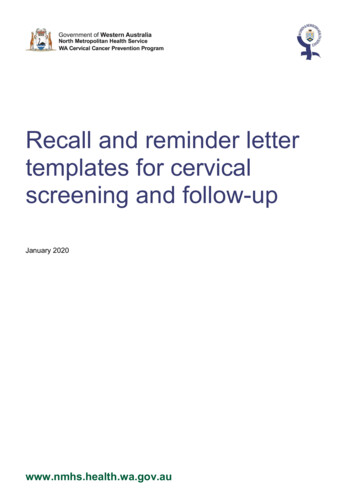
Transcription
Recall and reminder lettertemplates for cervicalscreening and follow-upJanuary 2020www.nmhs.health.wa.gov.au
ContentsPart A: Guide for the use of adaptable letter templates2Overview2Recall and reminder requirements2Tailoring letters to suit your audience2Letter timeframes2Confidentiality and record-keeping2Use of the National Interpreter Symbol3Selecting a ‘PROVIDER’ term3Engaging with patients that are under-screened3Additional information about cervical screening3National Cancer Screening Register4Part B: Overview of letter template types5Part C: Letter templates6Letter 1: Courtesy letter – rescreen in five years6Letter 2: Routine reminder – low risk7Letter 3: Courtesy letter – rescreen in 12 months8Letter 4: Recall – intermediate risk9Letter 5: Recall – intermediate risk 2ndcontactrd10Letter 6: Recall - intermediate risk 3 contact (REGISTERED POST)11Letter 7: Recall - higher risk12Letter 8: Recall - higher risk 2nd contact13Letter 9: Recall - higher risk Third contact (REGISTERED POST)14Letter 10: Recall - unsatisfactory outcome recommendation from laboratory15Letter 11: Recall - unsatisfactory outcome recommendation from laboratory 2 nd contact 16Letter 12: Recall - unsatisfactory outcome recommendation from laboratory 3rd contact(REGISTERED POST)17Letter 13: Reminder - under-screened participant18
Part A: Guide for the use of adaptable lettertemplatesOverviewThe National Cervical Screening Program (NCSP) is a population-based screening programthat aims to reduce the incidence and mortality of cervical cancer in Australia.Recall and reminder notifications from healthcare providers to patients, in alignment with theNCSP, are important to support the timely completion of cervical screening and follow-up tests.To assist healthcare providers with the implementation of effective recall and remindersystems, a suite of standardised and tested letter templates has been developed (seePart C). This document offers guidance regarding the use of these letter templates.Recall and reminder requirements Requirements for patient follow-up systems are outlined in the RACGP Standards forgeneral practices. These standards require general practices to have a ‘rigorous’ follow-up system toachieve accreditation. While there is no legal obligation for general practices to have a reminder system, GPsdo have a legal duty to recall patients to inform them about clinically significant testresults.Tailoring letters to suit your audience The letter templates have been informed through consultation with consumers and healthprofessionals. They can be used as a guide and adapted as needed.Letter timeframes Timing of recall and reminder correspondence is at the discretion of the practice,however should align with recommended timeframes outlined in the National CervicalScreening Program Guidelines (2016).A description of each template and suggested timings for sending letters/notifications areoutlined in Part B.Confidentiality and record keeping Plain envelopes marked as ‘private and confidential’ should be used and addressed tothe patient.Ensure a copy of the letter is saved in the patient’s health record.2
Use of the National Interpreter Symbol The National Interpreter Symbol is a national public informationsymbol developed by Victoria in partnership with theCommonwealth, state and territory governments.Displaying this symbol on patient letters can be a helpful way toshow that your health service offers language assistance.The National Interpreter Symbol can be downloaded online alongwith the Interpreter Symbol: guidelines for use.Selecting a ‘PROVIDER’ term Feedback from consumers and health professionals has shown that terms such as‘healthcare provider’ are not always understood.Depending on the audience, alternative terms such as ‘doctor’ or ‘nurse’ may be morerelevant or easier to understand, particularly for people with low literacy.When the letter template refers to [PROVIDER], consider your patient cohort and selectthe term that would be most relevant or easily understood.Some options to consider may include: doctor, nurse, GP, healthcare provider, Aboriginalhealth practitionerEngaging with patients that are under-screenedIt is recommended that letters sent to under-screened patients (i.e. those that are more than twoyears overdue for a Cervical Screening Test) are complimented with other recruitmentstrategies, for example making follow-up telephone calls or offering opportunistic cervicalscreening to patients attending for other appointments.Self-collection of a human papillomavirus (HPV) sample can also be offered as an alternativescreening option for eligible under-screened women. For more information about self-collection: Refer to the NCSP Clinical Management GuidelinesContact the WA Cervical Cancer Prevention Program on (08) 6458 1740 or emailcervicalscreening@health.wa.gov.auContact your practice’s pathology laboratoryAdditional information about cervical screeningA wide range of cervical screening resources for consumers and health professionals areavailable to download or order.For more information contact the WA Cervical Cancer Prevention Program on (08) 6458 1740or email cervicalscreening@health.wa.gov.au3
National Cancer Screening RegisterThe National Cancer Screening Register (the Register) is a national electronic infrastructure forthe collection, storage, analysis and reporting of screening program data.The Register currently supports the National Cervical Screening Program by: Maintaining a national database of cervical screening recordsProviding a participant’s cervical screening history to laboratories and healthcareproviders to inform screening and clinical management recommendationsInviting eligible persons to commence cervical screening when they turn 25 years of ageProviding a ‘safety net’ by:o reminding participants when they are due and overdue for cervical screeningo supporting participants who are at risk and have not attended further testing, byprompting them (and their healthcare providers) to have follow up testsWhile the Register provides a ‘safety net’ function for cervical screening and follow-up, it is stillimportant that healthcare providers maintain their own recall and reminder systems.To request a patient screening history call the National Cancer Screening Register on1800 627 701.For further information on the use of these letter templates or for general informationabout cervical screening, please contact the WA Cervical Cancer Prevention Program on13 15 56 or (08) 6458 1740.4
Part B: Overview of letter template typesLetter typeDescriptionRecommended timing fordelivery *1. Courtesy letter – rescreenin five yearsLetter advising participant that theirrecent Cervical Screening Test resultwas negative (HPV not detected) andthey are due to rescreen in five yearsFollowing a low risk CervicalScreening Test result2. Routine reminder – low riskLetter advising participant to return fora Cervical Screening Test, following aprevious low risk (i.e. normal) testresultWhen due to screen3. Courtesy letter – rescreenin 12 monthsLetter advising participant that theirrecent Cervical Screening Testdetected HPV (not 16/18) and theyare due for a repeat test in 12 monthsUpon confirmation of anintermediate risk test result, ifunable to contact by phone4. Recall – intermediate riskLetter advising participant to return fora follow-up test, following a previousintermediate risk resultWhen due for a follow-up test5. Recall – intermediate risk2nd contact6. Recall – intermediate risk3rd contact(Registered post)7. Recall – higher risk8. Recall – higher risk2nd contactEight weeks post due date ifstill no appointment has beenmadeLetter advising participant to return todiscuss test result (and receivereferral to a specialist), following ahigher risk test result9. Recall – higher risk3rd contact(Registered post)10. Recall – unsatisfactoryoutcome recommendationfrom laboratoryFour weeks post due date if noappointment has been madeUpon confirmation of a higherrisk test result, if unable tocontact by phoneFour weeks post due date if noappointment has been madeEight weeks post due date ifstill no appointment has beenmadeLetter advising participant to return fora retest in six weeks, following anunsatisfactory test resultUpon confirmation of anunsatisfactory test result, ifunable to contact by phone11. Recall – unsatisfactoryoutcome recommendationfrom laboratory2nd contactFour weeks post due date if noappointment has been made12. Recall – unsatisfactoryoutcome recommendationfrom laboratory3rd contact(Registered post)Eight weeks post due date ifstill no appointment has beenmade13. Reminder – underscreened participantLetter sent to participant advising toreturn for a Cervical Screening TestWhen patient is more than twoyears overdue for a CervicalScreening Test* Action taken when there is no knowledge and/or evidence of the patient having undertakentheir test elsewhere.5
Part C: Letter templatesLetter 1: Courtesy letter – rescreen in five years[PATIENT DETAILS][DATE]Dear [NAME]Thank you for having your Cervical Screening Test. Your test results show that humanpapillomavirus (HPV) was not found.This means you will be due for your next Cervical Screening Test in five years.At any time, if you have symptoms such as abnormal bleeding, discharge or pain, it isimportant you speak with your [PROVIDER].If you have any questions about your test result, please call [CLINIC NAME/PERSON]on [CLINIC PHONE NUMBER].Yours sincerely[PROVIDER NAME][PROVIDER TITLE]6
Letter 2: Routine reminder – low risk[PATIENT DETAILS][DATE]Dear [NAME]Your Cervical Screening Test is now due.Please call [CLINIC NAME/PERSON] on [CLINIC PHONE NUMBER] to book yourappointment.In Australia, the Pap smear has been replaced with a more accurate five-yearly CervicalScreening Test. It is important to have regular cervical screening, even if you have hadthe human papillomavirus (HPV) vaccination. Regular cervical screening is your bestprotection against cervical cancer.If you have recently had your Cervical Screening Test or have had a hysterectomy,please let us know so that we can update our records.Yours sincerely[PROVIDER NAME][PROVIDER TITLE]7
Letter 3: Courtesy letter – rescreen in 12 months[PATIENT DETAILS][DATE]Dear [NAME]Thank you for having your Cervical Screening Test.Your test results show that you are due for a repeat test in 12 months.If you wish to discuss your test results, please call [CLINIC NAME/PERSON] on[CLINIC NUMBER] to book an appointment.At any time, if you have symptoms such as abnormal bleeding, discharge or pain, it isimportant that you call the clinic on [CLINIC NUMBER] to book an appointment.Yours sincerely[PROVIDER NAME][PROVIDER TITLE]8
Letter 4: Recall – intermediate risk[PATIENT DETAILS][DATE]Dear [NAME]Your repeat Cervical Screening Test is now due.Please call [CLINIC NAME/PERSON] on [CLINIC PHONE NUMBER] to book anappointment.If you have recently had your follow-up test or have had a hysterectomy, please let usknow so that we can update our records.Yours sincerely[PROVIDER NAME][PROVIDER TITLE]9
Letter 5: Recall – intermediate risk2nd contact[PATIENT DETAILS][DATE]Dear [NAME]Your repeat Cervical Screening Test is now overdue.Please call [CLINIC NAME/PERSON] on [CLINIC PHONE NUMBER] to book anappointment.Human papillomavirus (HPV) causes cervical cell changes and most cervical cancers. Itis important that you attend for your repeat test to ensure that HPV is no longer present.If you have recently had your repeat test or have had a hysterectomy, please let usknow so that we can update our records.Yours sincerely[PROVIDER NAME][PROVIDER TITLE]10
Letter 6: Recall - intermediate risk3rd contact (REGISTERED POST)[PATIENT DETAILS][DATE]Dear [NAME]Your repeat Cervical Screening Test is now overdue.To book an appointment, please call [CLINIC NAME/PERSON] on [CLINIC PHONENUMBER].Human papillomavirus (HPV) causes cervical cell changes and most cervicalcancers. It is important that you attend for your repeat test to ensure that HPV is nolonger present.If you have recently had your repeat test or have had a hysterectomy, please let usknow so that we can update our records.This is our third attempt at contacting you via letter and is the final reminder that wewill send. Please contact us as soon as possible.Yours sincerely[PROVIDER NAME][PROVIDER TITLE]11
Letter 7: Recall - higher risk[PATIENT DETAILS][DATE]Dear [NAME]Your Cervical Screening Test results show that further investigation is needed.It is important that you discuss these results with your [PROVIDER].To book an appointment please call [CLINIC NAME] on [CLINIC PHONE NUMBER].Yours sincerely[PROVIDER NAME][PROVIDER TITLE]12
Letter 8: Recall - higher risk2nd contact[PATIENT DETAILS][DATE]Dear [NAME]Your Cervical Screening Test results show that further investigation is needed.It is important that you discuss these results with your [PROVIDER].To book an appointment, please call [CLINIC NAME] on [CLINIC PHONE NUMBER].Yours sincerely[PROVIDER NAME][PROVIDER TITLE]13
Letter 9: Recall - higher riskThird contact (REGISTERED POST)[PATIENT DETAILS][DATE]Dear [NAME]Your Cervical Screening Test results show that further investigation is needed.It is important that you discuss these results with your [PROVIDER].To book an appointment, please call [CLINIC NAME/PERSON] on [CLINIC PHONENUMBER].This is our third attempt at contacting you via letter and is the final reminder that wewill send. Please contact us as soon as possible.Yours sincerely[PROVIDER NAME][PROVIDER TITLE]14
Letter 10: Recall - unsatisfactory outcome recommendation from laboratory[PATIENT DETAILS][DATE]Dear [NAME]Please book to repeat your Cervical Screening Test.The laboratory that examined your Cervical Screening Test could not provide a result.This means the test needs to be repeated in six weeks.Please call [CLINIC NAME/PERSON] on [CLINIC PHONE NUMBER] to book anappointment to repeat your test.If you have had your repeat test, please let us know so that we can update ourrecords.Yours sincerely[PROVIDER NAME][PROVIDER TITLE]15
Letter 11: Recall - unsatisfactory outcome recommendation from laboratory2nd contact[PATIENT DETAILS][DATE]Dear [NAME]Your repeat Cervical Screening Test is overdue.The laboratory that examined your Cervical Screening Test could not provide a result,meaning a repeat test is needed.Please call [CLINIC NAME] on [CLINIC PHONE NUMBER] to book an appointment torepeat your test.If you have had your repeat test, please let us know so that we can update ourrecords.Yours sincerely[PROVIDER NAME][PROVIDER TITLE]16
Letter 12: Recall - unsatisfactory outcome recommendation from laboratory3rd contact (REGISTERED POST)[PATIENT DETAILS][DATE]Dear [NAME]Your repeat Cervical Screening Test is overdue.The laboratory that examined your Cervical Screening Test could not provide a result.Please call [CLINIC NAME] on [CLINIC PHONE NUMBER] to book an appointment torepeat your test.If you have had your repeat test, please let us know so that we can update you records.This is our third attempt at contacting you via letter and is the final reminder that we willsend. Please contact us as soon as possible.Yours sincerely[PROVIDER NAME][PROVIDER TITLE]17
Letter 13: Reminder - under-screened participant[PATIENT DETAILS][DATE]Dear [NAME]Your Cervical Screening Test is overdue.In Australia, the Pap smear has been replaced with a more accurate five-yearly CervicalScreening Test. Regular cervical screening is your best protection against cervicalcancer.Please call [CLINIC NAME/PERSON] on [CLINIC PHONE NUMBER] to discuss yourcervical screening options and book an appointment.If you have recently had your Cervical Screening Test or have had a hysterectomy,please let us know so that we can update our records.Yours sincerely[PROVIDER NAME][PROVIDER TITLE]18
Feedback welcomeSuggestions to improve this resource are encouraged to be directed to theWA Cervical Cancer Prevention Program.Please email any feedback to cervicalscreening@health.wa.gov.au oralternatively call (08) 6458 1740.This project was undertaken in collaboration with the WA Primary Health Allianceand Cancer Council WA.This document can be made available in alternative formatson request for a person with a disability. North Metropolitan Health Service 2020Copyright to this material is vested in the State of Western Australia unless otherwise indicated. Apartfrom any fair dealing for the purposes of private study, research, criticism or review, as permitted underthe provisions of the Copyright Act 1968, no part may be reproduced or re-used for any purposeswhatsoever without written permission of the State of Western Australia.19
Letter 7: Recall - higher risk 12 Letter 8: Recall - higher risk 2nd contact 13 Letter 9: Recall - higher risk Third contact (REGISTERED POST) 14 Letter 10: Recall - unsatisfactory outcome recommendation from laboratory 15 Letter 11: Recall - unsatisfactory outcome recommendation from laboratory 2nd contact 16
